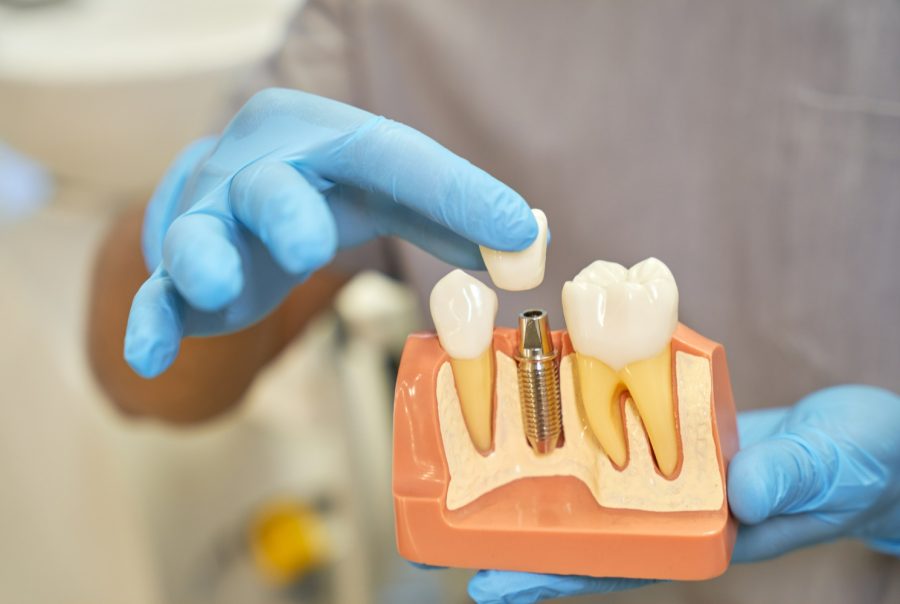Get information about impacted tooth extraction treatment with the detailed explanation of specialist dentist Seher Arseven.
Impacted Tooth Extraction

Impacted Tooth Extraction Turkey, Antalya.
Sometimes, our mouths can have unexpected anomalies. Teeth trapped in the jawbone or gums can cause serious problems if unnoticed or untreated. So, what is an impacted tooth, why does it occur, and how is it treated?
What is an Impacted Tooth?
An impacted tooth is a tooth that fails to erupt into the dental arch within the expected developmental window. It can remain completely beneath the gum line or partially emerge. While commonly seen with wisdom teeth, it can occur with other teeth as well.
Why Do Impacted Teeth Occur?
There are various reasons for impacted teeth:
- Jaw Structure: Insufficient jaw development or a narrow jaw can result in inadequate space for teeth to emerge.
- Genetic Factors: A family history of impacted teeth can increase an individual’s risk. Genetic predisposition can affect the number, size, or position of teeth.
- Teeth Crowding: Misalignment or overcrowding of teeth can predispose to impaction. Premature or delayed loss of primary teeth can also contribute to crowding.
- Misalignment: Teeth may become impacted if they grow in the wrong direction or are positioned abnormally within the jawbone.
- Other Factors: Trauma, infection, cysts, or tumors can also cause teeth to become impacted. Certain systemic diseases or developmental disorders can increase the risk of impaction.
The exact cause of an impacted tooth is not always clear. However, early diagnosis and treatment can prevent or minimize the associated complications.
Complications of Untreated Impacted Teeth
Untreated impacted teeth can lead to various health issues over time:
- Infection: The tissue around an impacted tooth can become infected, leading to pain, swelling, redness, fever, and bad breath. If untreated, the infection can spread to lymph nodes and surrounding tissues.
- Cysts and Tumors: Cysts, and rarely tumors, can form around an impacted tooth, potentially damaging the jawbone and neighboring teeth, and causing significant complications if left untreated.
- Damage to Adjacent Teeth: An impacted tooth can exert pressure on neighboring teeth, causing them to shift, become loose, or their roots to be damaged. This can result in tooth decay, loosening, or even loss of the affected teeth.
- Gum Disease: The gums around an impacted tooth can become inflamed (pericoronitis), leading to pain, swelling, bleeding, and bad breath. Untreated inflammation can cause gum recession and bone loss.
- Jaw Joint Problems: Impacted teeth can cause pain, clicking, or locking in the jaw joint.
- Oral Hygiene Challenges: Cleaning around an impacted tooth is difficult, increasing the risk of plaque buildup and cavities, leading to bad breath, gum inflammation, and other oral health issues.
- Systemic Effects: Rarely, infections from impacted teeth can spread to the body, affecting the heart, kidneys, or brain, especially in individuals with weakened immune systems.
The problems caused by impacted teeth can vary from person to person.
How is Impacted Tooth Extraction Surgery Performed?
The procedure for extracting an impacted tooth depends on its position, depth, and relationship with surrounding tissues. Generally, the following steps are involved:
- Evaluation and Preparation: The dentist conducts a thorough examination and takes X-rays to assess the position of the impacted tooth, its root structure, and its relationship with surrounding tissues. Additional imaging methods (such as a CT scan) may be used if necessary. The patient’s general health and allergies are also considered.
- Anesthesia: The procedure is typically performed under local anesthesia. General anesthesia or sedation may be used depending on the dentist’s decision.
- Gum Incision: The gum tissue covering the impacted tooth is carefully cut and lifted to expose the tooth.
- Bone Removal: If necessary, the bone covering the tooth is removed with special instruments to facilitate extraction.
- Tooth Extraction: The tooth is extracted either in one piece or in sections, depending on its complexity. If the tooth’s roots are firmly anchored in the surrounding tissues, the extraction process may be more challenging.
- Cleaning and Suturing: The extraction site is cleaned, and bleeding is controlled. The gum incision is closed with stitches, although suturing may not always be necessary.
- Recovery: Postoperative painkillers, antibiotics, and mouth rinses may be prescribed. Following the dentist’s recommendations is crucial to speed up recovery and reduce the risk of complications.
Impacted tooth extraction surgery usually takes between 30 minutes and 1 hour, depending on the tooth’s position and complexity. Postoperative pain, swelling, and bleeding are common and typically resolve within a few days.
Cost of Impacted Tooth Extraction
The cost of impacted tooth extraction can vary based on several factors:
- Location of the Impacted Tooth: The depth of impaction affects the complexity and duration of the extraction, with deeper impactions being more costly.
- Number of Impacted Teeth: Extracting multiple impacted teeth will increase the total cost.
- Complexity of the Extraction: Teeth with roots firmly anchored in surrounding tissues or those in difficult positions may incur higher costs.
As of 2024, the average cost of impacted tooth extraction in Turkey ranges from 130 $ to 300 $. However, prices can vary beyond this range depending on the factors mentioned above.
For an accurate price estimate, a dental examination is necessary to create a personalized treatment plan. The dentist will provide detailed information about the procedure and associated costs.
Postoperative Recovery
The general postoperative recovery process for impacted tooth extraction is as follows:
First 24 Hours:
- After the anesthesia wears off, mild to moderate pain, swelling, and bleeding can occur.
- Applying a cold compress can help reduce swelling and alleviate pain.
- It is essential to take the prescribed painkillers and antibiotics as directed.
- Avoid smoking, alcohol consumption, and hot beverages for the first 24 hours.
- Soft and lukewarm foods should be consumed, avoiding pressure on the extraction site.
2-3 Days:
- Pain and swelling gradually decrease.
- Mild bruising may occur.
- A white layer may form over the extraction site, indicating normal healing.
- Rinsing with saltwater helps maintain oral hygiene and speed up healing.
- Careful brushing is important to avoid damaging the extraction site.
1 Week:
- Pain and swelling significantly reduce or disappear.
- The gum begins to heal.
- Stitches, if present, are removed.
- Normal dietary habits can resume, avoiding hard and sticky foods.
2-3 Weeks:
- Healing of the extraction site continues.
- Bone tissue gradually regenerates.
- Complete healing may take several months.
If any signs of infection (fever, severe pain, foul odor, excessive bleeding) or unexpected symptoms occur during the recovery period, contact your dentist immediately. Adhering to these guidelines will help ensure a smooth recovery process.
Seher Arseven
She graduated from Hacettepe University Faculty of Dentistry in 2016. Between 2016 and 2018, she worked at Liv Hospital. After completing a six-year training program at Gazi University Faculty of Dentistry, Department of Periodontology, she obtained her PhD. She specializes in aesthetic gingival surgeries, the treatment of gingival recessions, and gingival diseases, with her thesis focusing on peri-implantitis and implant surgeries. She has numerous national and international publications related to peri-implantitis and implant treatments. Additionally, she is skilled in advanced bone surgeries.

